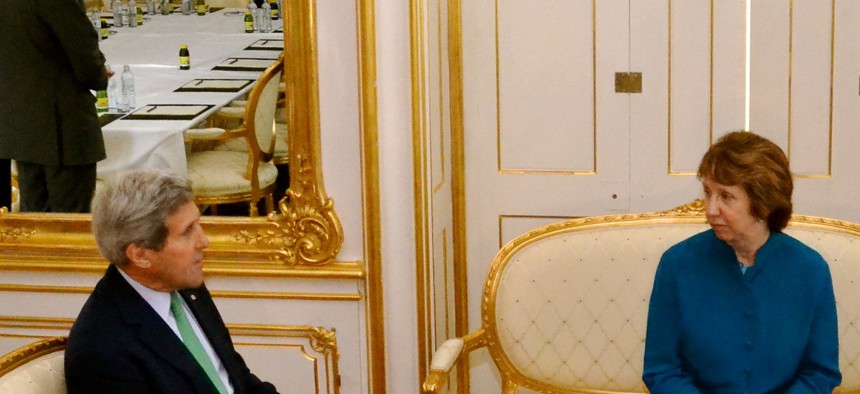
Secretary of State John Kerry sits down with EU High Representative Catherine Ashton and Iranian Foreign Minister Javad Zarif in Vienna, on October 15, 2014. State Department
The Last Step to an Iran Nuclear Deal
Washington is too focused on Iran’s ability to enrich nuclear material instead of our ability to watch them. By Greg Thielmann
As Iran and the “P5+1” countries resume talks in Vienna this week, the primary hurdle before their self-imposed Nov. 24 deadline for completing a final deal now is the wide gap between positions on the size and scope of Iran’s uranium enrichment capabilities. But the enrichment question should not detract from the importance of another important goal: verification in the comprehensive agreement.
The number of Iranian centrifuges installed and operating is certainly an important issue. It is fair for the P5+1 to expect Iran to adjust its nuclear program so that its enrichment capacity is “consistent with [its] practical needs,” as agreed by both sides in the November 2013 interim agreement. Without such limits, Iran would be better able to quickly build a nuclear bomb.
But it is also important to understand the context of any such dash to weaponize. U.S. intelligence officials have testified since 2007 that if Iran were to make the decision to build a nuclear weapon, it would probably “use covert facilities—rather than its declared nuclear sites—for the production of highly enriched uranium for a weapon.”
Blocking this clandestine path to a bomb–sometimes known as “sneakout”–should therefore be a top goal for the P5+1. Iran has already agreed to more intrusive International Atomic Energy Agency, or IAEA, scrutiny of its nuclear sites as part of last year’s interim nuclear agreement. But to guard against “sneakout,” it is essential that a more robust international monitoring and inspection system that can help detect and deter potential weapons work at any secret sites is put in place. The only way to achieve this is through a long-term comprehensive nuclear deal. Negotiators, as well as members of Congress, must recognize that unrealistic demands to dismantle all of Iran’s centrifuges would jeopardize reaching a final deal, cutting off the only way to secure enhanced inspection rights for IAEA inspectors.
To achieve adequate verification, a comprehensive agreement should, among other things, require implementation of the “Additional Protocol” to the IAEA’s safeguards agreement with Iran under the nuclear Non-proliferation Treaty. This would grant the U.N. nuclear watchdog the authority to inspect any site that it suspected was being used for nuclear weapons work, whether or not it had been declared as part of Iran’s nuclear program.
Unfortunately, the discussion in Washington is currently focused almost exclusively on Iran’s enrichment program. It is important to remember that enriching uranium gas to weapons-grade purity is only one component in the complex process required to build a reliable and deliverable nuclear weapon–a process that even now would take Iran over a year. Setting realistic, verifiable limits on Iran’s uranium enrichment program is, nevertheless, important. Iran has around 20,000 centrifuges installed and is operating about 10,000. The P5+1 wants to significantly reduce that number, which would increase the time it would take to produce bomb grade material. The two sides are exchanging proposals, but have not yet found a mutually acceptable formula. There are several elements they can and must consider, including the number and efficiency of the centrifuge machines, whether new machines are developed over time and the duration of the limits.
We also must understand that no matter the outcome of these talks, we will never be able to negotiate away the Iranians’ technical know-how and ability to eventually develop and build a nuclear weapon if they chose to do so. Thus, while it is important that the number of Iran’s centrifuges don’t exceed legitimate civilian nuclear needs, which are now very low, we must persuade the Iranians that making the decision to build a nuclear weapon is not in their best interest. Tehran must be convinced that efforts to build a bomb would be rapidly detected and would lead to dire consequences.
A comprehensive and intrusive verification regime is essential because it can help deter Iran from being tempted to make a dash for a bomb in the first place.
NEXT STORY: Contain ISIS, Then Roll It Back




